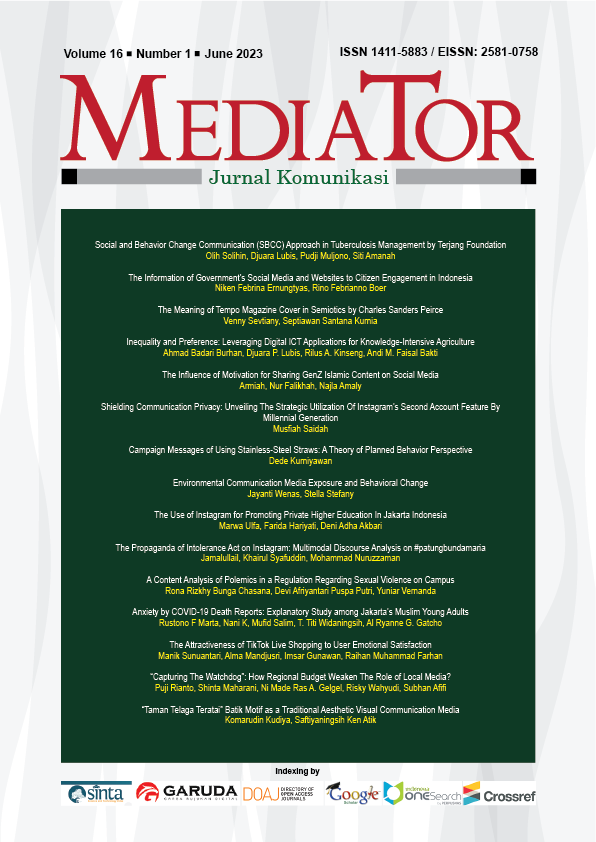The Influence of Motivation for Sharing GenZ Islamic Content on Social Media
DOI:
https://doi.org/10.29313/mediator.v16i1.2187Keywords:
The Influence, Motivation, Sharing, Islamic Content, GenZAbstract
UIN Antasari students like and post Islamic websites through announcements of religious assemblies, videos of religious lectures, and motivational sentences, and are even active as volunteers for Islamic media such as Aswaja Net and Al Jami. The behavior of sharing Islamic content becomes interesting when it is associated with their motivational background in sharing content with others. The initial hypothesis is that there is a desire to invite others to do good, provide assistance, support each other, and prevent reprehensible actions. This study uses a mix method approach. The data collection technique is by distributing google form questionnaires and FGDs. Data analysis technique was performed by multiple linear regression analysis. The results of the study based on a sample of 566 students found that motivation and intensity simultaneously influence the behavior of sharing Islamic content. The effect value of the independent variable on the dependent variable is 58.5%. The motivation for sharing Islamic content includes selfactualization motivation in preaching as much as 75.6% and to get responses from other people as much as 72.4%. Meanwhile, the intensity of accessing Islamic content was 45.9% 2-5 times per day and 41.3% less than 10 minutes.
References
Ardha, B. (2014). Social Media Sebagai Media Kampanye Partai Politik 2014 Di Indonesia. Jurnal Visi Komunikasi, 13(01), 105–120.
Browman, A. S. (2017). Running Head: Identity-Specific Motivations Identity-Specific Motivation: How Distinct Identities Direct Self-Regulation across Distinct Situations Alexander S. Browman. Journal of Personality and Social Psychology ©.
Chang, H. H., & Chuang, S. S. (2011). Social capital and individual motivations on knowledge sharing: Participant involvement as a moderator. Information and Management, 48(1), 9–18. https://doi.org/10.1016/j. im.2010.11.001
Child, J. T., & Haridakis, P. (2018). Uses and Gratifications Theory. Engaging Theories in Family Communication, 337–348. https://doi. org/10.4324/9781315204321-30
Darmawan, F. (2020). Bab ii kajian pustaka bab ii kajian pustaka 2.1. Bab Ii Kajian Pustaka 2.1, 12(2004), 6–25.
Dimas Bayu. (2022). APJII : Pengguna Internet Indonesia Tembus 210 juta pada Tahun 2022. In DataIndonesia. https://dataindonesia.id/digital/detail/ apjii-pengguna-internet-indonesia-tembus-210-juta-pada-2022
Dzar Nurul Halimah, & Nawangsih, E. (2021). Studi Deskriptif Mengenai Happiness pada Mahasiswa Pengguna Media Sosial di Kota Bandung. Jurnal Riset Psikologi, 1(1), 7–11. https://doi. org/10.29313/jrp.v1i1.87
Falgoust, G., Winterlind, E., Moon, P., Parker, A., Zinzow, H., & Chalil Madathil, K. (2022). Applying the uses and gratifications theory to identify motivational factors behind young adult’s participation in viral social media challenges on TikTok. Human Factors in Healthcare, 2(December 2021), 100014. https:// doi.org/10.1016/j.hfh.2022.100014
Ferrara, E., & Yang, Z. (2015). Quantifying the effect of sentiment on information diffusion in social media. PeerJ Computer Science, 2015(9). https:// doi.org/10.7717/peerj-cs.26
Gallion, A. J. (2014). Applying the Uses and Gratifications to Social Networking SItes. Contemporary Educational Technology, 5(1), 53–7.
Grellhesl, M., & Punyanunt-Carter, N. M. (2012). Using the uses and gratifications theory to understand gratifications sought through text messaging practices of male and female undergraduate students. Computers in Human Behavior, 28(6), 2175–2181. https://doi.org/10.1016/j. chb.2012.06.024
Ha, L., Leconte, D., & Savidge, J. (2013). From TV to the Internet to Mobile Phones: A National Study of U.S. College Students’ Multiplatform Video Use and Satisfaction. Frontiers in New Media Research, 278–298. https://doi. org/10.4324/9780203113417-26
Handoko, M. R., & Stellarosa, Y. (2020). The Influence of President Joko Widodo’s Instagram Content on Beginner Voters Participation in the 2019 General Elections. Mediator: Jurnal Komunikasi, 13(1), 24–38. https://doi. org/10.29313/mediator.v13i1.5161
Hanson, G., & Haridakis, P. (2008). YouTube users watching and sharing the news: A uses and gratifications approach. In Journal of Electronic Publishing (Vol. 11, Issue 3). https://doi. org/10.3998/3336451.0011.305
Helsper, E. J., & Eynon, R. (2010). Digital natives: Where is the evidence? British Educational Research Journal, 36(3), 503–520. https://doi. org/10.1080/01411920902989227
Hidayat, Z., Saefuddin, A., & Sumartono, S. (2017). Motivasi, Kebiasaan, dan Keamanan Penggunaan Internet. Jurnal ILMU KOMUNIKASI, 13(2), 129–150. https://doi.org/10.24002/jik. v13i2.675
Jones, C., & Healing, G. (2010). Net generation students: Agency and choice and the new technologies. Journal of Computer Assisted Learning, 26(5), 344–356. https://doi.org/10.1111/ j.1365-2729.2010.00370.x
Kahar, I. (2018). The Influence Of Motivation And Learning Interest Of Grade X Students On Upper Servisce Learning Result In Volleyball At Sman 18 Luwu. 2. http://eprints.unm. ac.id/10662/1/JURNAL.pdf
Karman. (2013). Riset Penggunaan Media dan Perkembangannya Kini - Researches on Media Uses And Its Development. Jurnal Studi Komunikasi Dan Media, 17(1), 103–121. http://dx.doi. org/10.31445/jskm.2013.170106
Kaspar, K., & Müller-Jensen, M. (2021). Information seeking behavior on Facebook: The role of censorship endorsement and personality. Current Psychology, 40(8), 3848–3859. https:// doi.org/10.1007/s12144-019-00316-8
Kurnia, H. (2017). The Influence of Motivation Factors Toward Knowledge Sharing Intention and Its Impact to Knowledge Sharing Behavior Between Employees at PT. Telkom Divre 3 Jabar. 3rd International Conference on Transformation in Communication (ICoTiC 2017), 150(ICoTiC 2017), 22–30.
Kusumalestari, R. R., Satriani, A., Permatasari, A. N., Anjani, M., & Nadifah, N. N. (2021). Gen Z’s Reception of Covid-19 Information on Digital Media. Mediator: Jurnal Komunikasi, 14(2), 157–167. https:// doi.org/10.29313/mediator.v14i2.8387
Mahmudah, S. (2019). Hubungan Intensitas dalam Mengikuti Dakwah Melalui Media Sosial Dengan Minat Belajar Agama pada Mahasiswa Program Studi Pendidikan Agama Islam ( PAI ) di IAIN Kediri (pp. 17–34).
Mahmuddin, & Halik, A. (2019). The use of social media as a source of religious knowledge among doctors in Makassar, Indonesia. Jurnal Komunikasi: Malaysian Journal of Communication, 35(4), 272–285. https://doi. org/10.17576/JKMJC-2019-3504-17
Makam, S. B. (2013). Social Networking Sites : Segmenting Young Users on Motivations. Taylor’s Business Review, X(1), 1–25.
Maria, S. (2017). A Comparative Research On The Effect Using REAP and RAFT Strategies on Students’ Writing Ability at SMPN 1 Kuantan Hilir Seberang (pp. 23–30).
Millanyani, H., & Pramiyanti, A. (2015). Uses and Gratification Analysis of Social Media in K-Pop Information Searching. International Conference on Transformation in Communication. https://openlibrarypublications. telkomuniversity.ac.id/index.php/ icotic/article/download/5636/5611
Mustafa, S. E., & Hamzah, A. (2011). Online Social Networking: A New Form of Social Interaction. International Journal of Social Science and Humanity, 1(2), 96–104. https://doi. org/10.7763/ijssh.2011.v1.17
Muyasaroh, M. (2020). Hubungan Antara Kepemimpinan Situasional Guru Dengan Minat Belajar Siswa Kelas Unggulan Dalam Mata Pelajaran PAI Di MTsN 2 Nganjuk Tahun Ajaran 2019/2020.Nugroho, I., & Irwansyah, I. (2021). Konvergensi Konten Audio di Media Online (Studi Kasus Podcast Detik. com). Jurnal Komunikasi, 15(1), 55– 70. https://doi.org/10.21107/ilkom. v15i1.9753
Pramesti, O. L. (2022). The Practice of Digital Ethics among TikTok Content Creators. 15(December), 236–248.
Ruggiero, T. E. (2000). Uses and Gratifications Theory in the 21st Century. Mass Communication and Society, 3(1), 3–37. https://doi.org/10.1207/ s15327825mcs0301_02
Salehan, M., Kim, D. J., & Kim, C. (2017). Use of Online Social networking servicesfrom a theoretical perspective of the motivation-participation-performanceframework. Journal of the Association for Information Systems, 18(2), 141–172. https://doi. org/10.17705/1jais.00449
Saputra, P. (2017). Perilaku Penemuan Informasi Di Kalangan Muallaf Masjid Al Falah Surabaya.
Satriani, A., & Rinawati, R. (2020). Hubungan antara Pengetahuan Budaya Korea dengan Keputusan Pembelian Handphone Korea. Mediator: Jurnal Komunikasi, 13(1), 1–10. https://doi. org/10.29313/mediator.v13i1.5123
Stiveni Isadora, Shinta Pratiwi, P. T. (2012). Perbedaan Motif Afiliasi Pada Remaja Pengguna Facebook Ditinjau Dari Jenis Kelamin. Intuisi Jurnal Psikologi Ilmiah.
Sulthan, M., & Istiyanto, S. B. (2019). Model Literasi Media Sosial Bagi Mahasiswa. Jurnal ASPIKOM, 3(6), 1076. https:// doi.org/10.24329/aspikom.v3i6.280
Szell, M., Lambiotte, R., & Thurner, S. (2010). Multirelational organization of large-scale social networks in an online world. Proceedings of the National Academy of Sciences of the United States of America, 107(31), 13636–13641. https://doi.org/10.1073/ pnas.1004008107
Usman, F. (2016). Efektivitas Penggunaan Media Online Sebagai Sarana Dakwah. Jurnal Ekonomi Dan Dakwah Islam (Al-Tsiqoh), 1(1), 1–8.
Wang, Z., & Wang, N. (2012). Expert Systems with Applications Knowledge sharing , innovation and firm performance. Expert Systems With Applications, 39(10), 8899–8908. https://doi. org/10.1016/j.eswa.2012.02.017
Wibowo, T. O. (2018). Fenomena Website Streaming Film di Era Media Baru: Godaan, Perselisihan, dan Kritik. Jurnal Kajian Komunikasi, 6(2), 191. https://doi.org/10.24198/jkk. v6i2.15623
Zaini, A. (2013). Dakwah Melalui Internet. Komunikasi Penyiaran Islam, 1(1), 93–108.
Downloads
Published
Issue
Section
License
Copyright (c) 2023 Author

This work is licensed under a Creative Commons Attribution-ShareAlike 4.0 International License.























